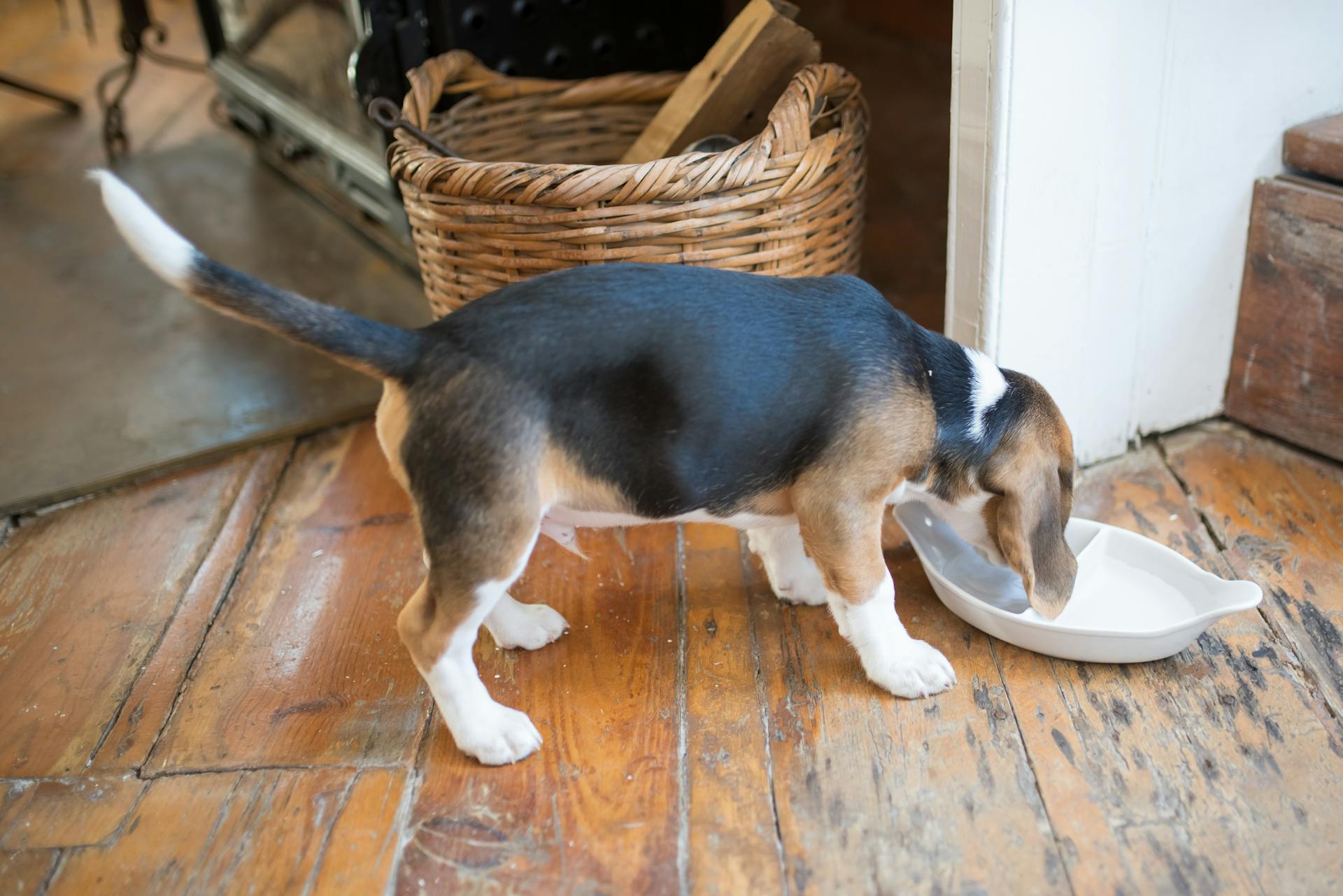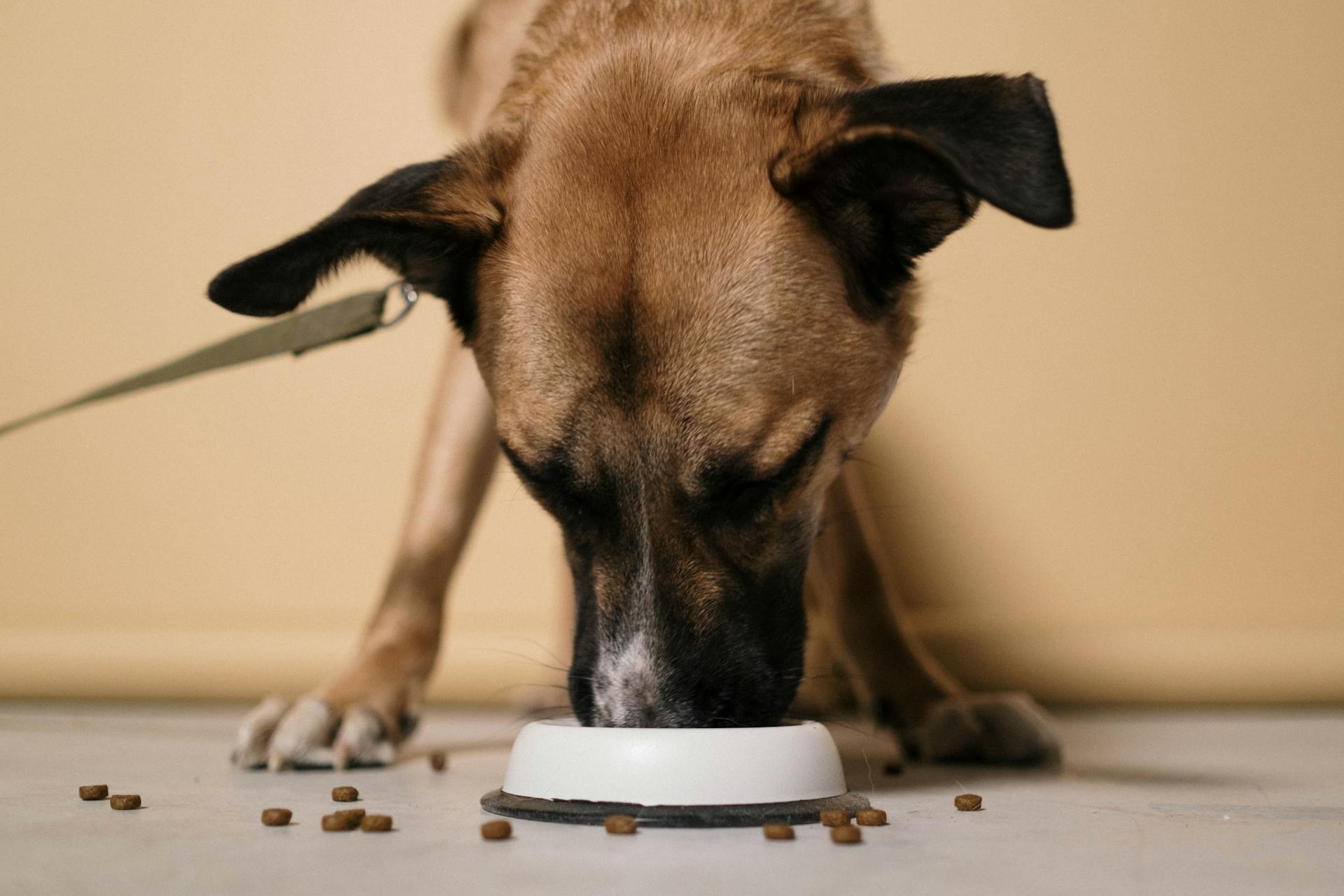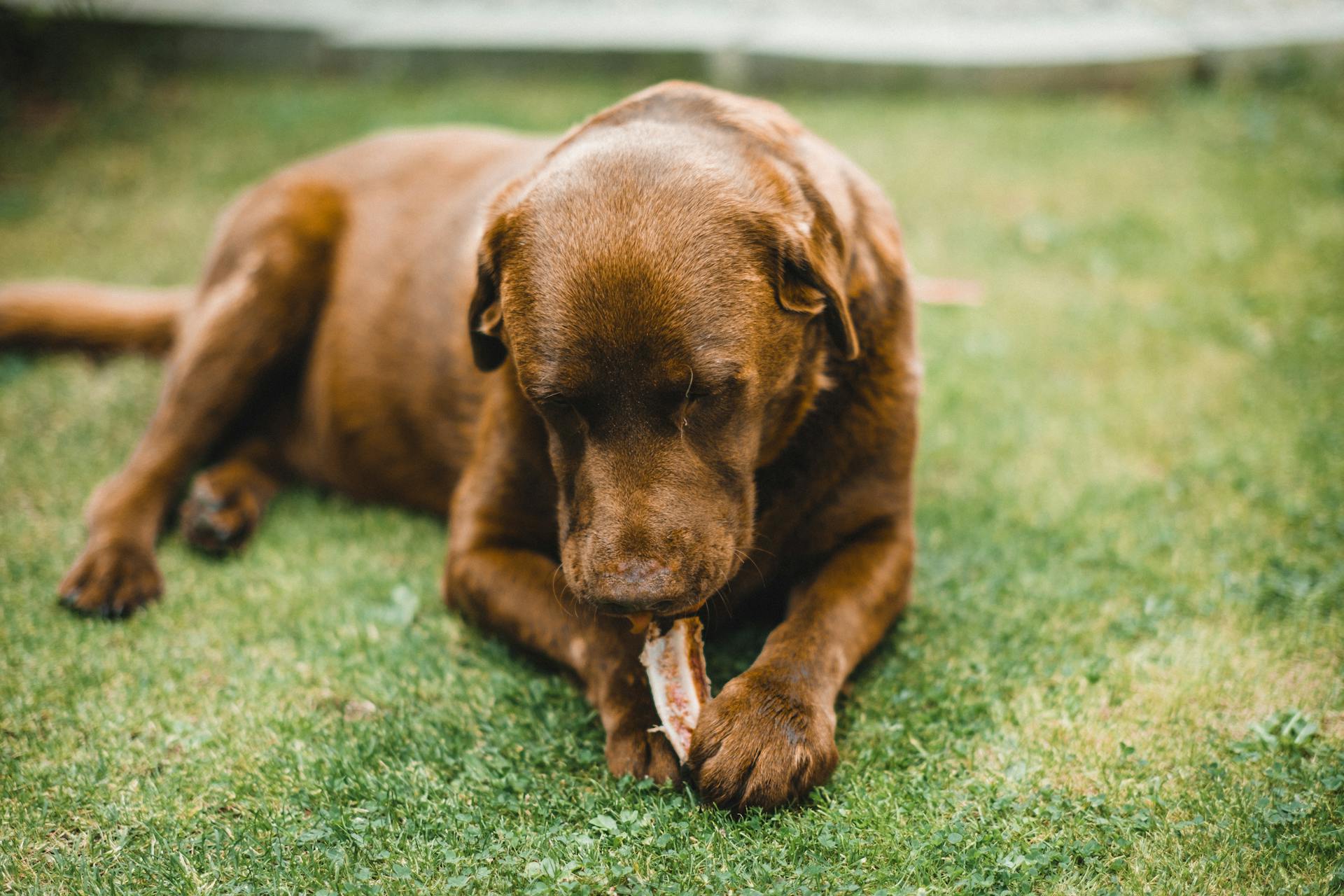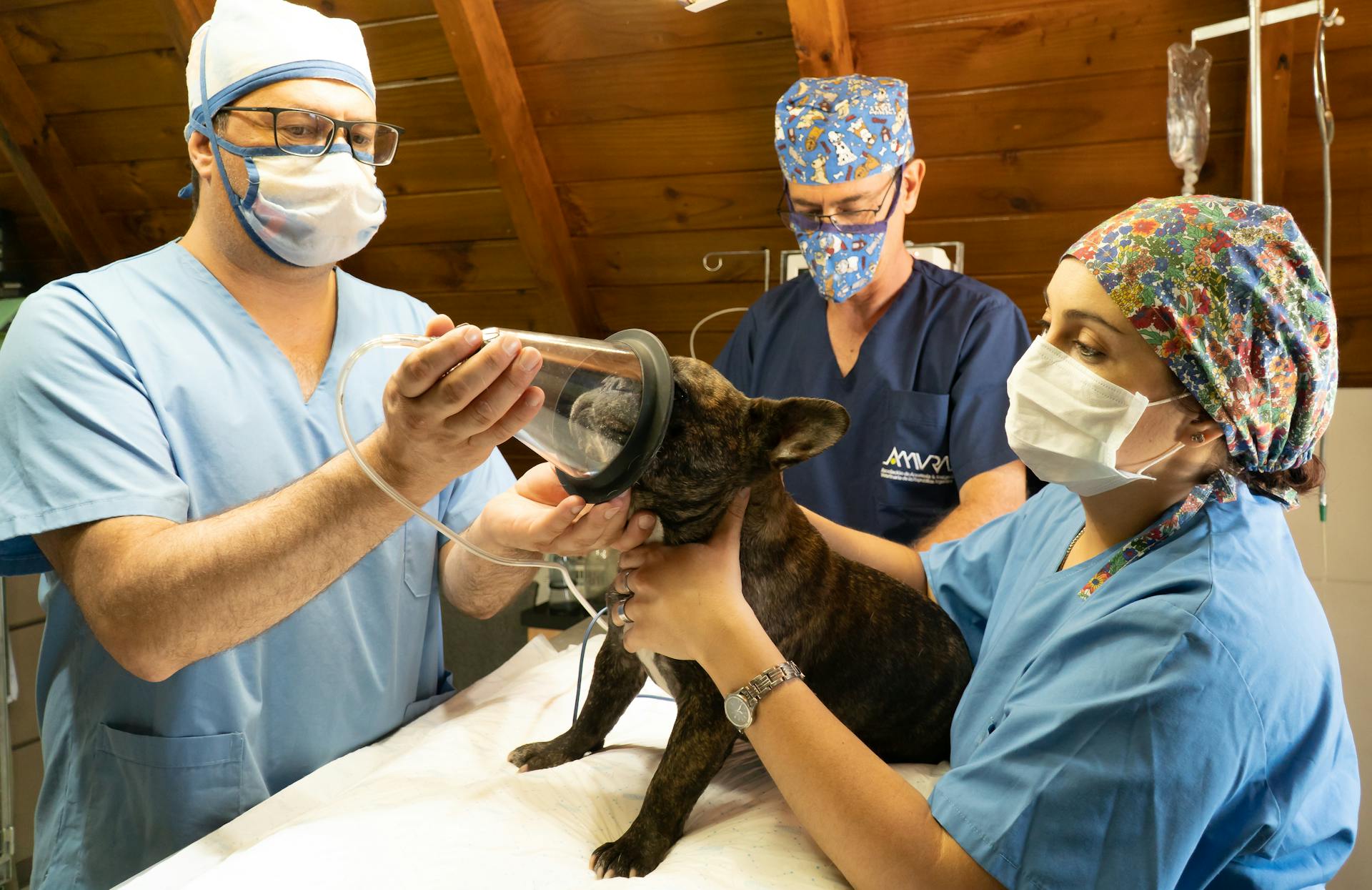
Understanding the dog bloat timeline is crucial to preventing this life-threatening condition. Typically, a dog's stomach can expand up to 5 times its normal size within 15 minutes of eating.
The first signs of bloat can appear within 30 minutes to an hour after eating, often accompanied by restlessness and pacing. Sometimes, a dog may exhibit a hard, swollen abdomen.
During this critical period, it's essential to monitor your dog's behavior and watch for signs of distress, such as panting, drooling, or trying to vomit. If you notice any of these symptoms, seek veterinary attention immediately.
In severe cases, bloat can lead to gastric dilatation-volvulus (GDV), a condition where the stomach twists and cuts off blood flow. This can happen within 1-2 hours of eating.
Worth a look: Signs Your Dog Doesn't Have Bloat
What Is GDV?
GDV, also known as gastric dilatation-volvulus, is a serious and potentially life-threatening condition that can affect dogs.
It occurs when the stomach twists or fills with gas, cutting off blood flow and oxygen to the stomach and other organs.
This can happen in as little as 30 minutes, causing severe pain, vomiting, and lack of appetite.
A dog's stomach can twist and fill with gas quickly, often due to eating too much or eating too fast, which can lead to GDV.
The stomach can twist and cut off blood flow, leading to tissue death and organ failure if left untreated.
If you suspect your dog is experiencing GDV, seek veterinary attention immediately.
Signs and Symptoms
Signs of dog bloat can be subtle, but recognizing them early on is crucial. Restlessness and pacing are often the first signs you'll notice.
A swollen or distended abdomen is a clear indication that something is wrong. Your dog may also exhibit painful abdomen behavior, looking like they're in distress.
Other warning signs include excessive drooling, panting or rapid breathing, and collapse or inability to stand. These symptoms can progress quickly, so it's essential to be vigilant.
Here are some factors that increase the risk of canine bloating:
- Large breeds, such as Great Danes, German Shepherds, Doberman Pinchers, and Boxers, are at higher risk
- Feeding one large meal per day
- Having a family history of bloat
- Being thin or underweight
- Rapid eating
- Having an anxious, fearful, or nervous temperament
- Consuming moistened dry food, particularly if citric acid is used as a preservative
What Is Gdv? Risks
GDV, or gastric dilatation and volvulus, is a life-threatening condition that can affect dogs. In the early stage, it's characterized by a simple gastric dilatation or "bloating", where the stomach fills with gas.
The condition can progress into a volvulus, where the gas-filled stomach twists to block both the entrance and exit of the stomach, becoming a life-threatening emergency that requires urgent surgery to correct.
The exact cause of GDV is still unknown, but it's thought that exercise after eating large meals or drinking a lot of water might increase the risk.
Signs/Symptoms
The signs and symptoms of canine bloat can be quite distressing to witness, but recognizing them early on is crucial to increasing your dog's chances of survival. Restlessness and pacing are often the first signs that something is amiss.
Your dog's abdomen may become swollen or distended, which can be a clear indication of bloat. You may also notice that your dog is in a lot of pain, which can lead to an overall look of distress.
retching or attempts to vomit with no success are common symptoms of bloat, and excessive drooling is also a telltale sign. Panting or rapid breathing can be a sign that your dog is struggling to breathe.

As the condition progresses, your dog may become unsteady on its feet and can even collapse. This is a critical moment, and immediate veterinary attention is essential.
Here are some risk factors to be aware of:
- Large breeds, especially those with deep chests, are at higher risk
- Feeding one large meal per day can increase the risk
- Having a family history of bloat is also a factor to consider
- Being thin or underweight can increase the risk
- Rapid eating can also contribute to the risk of bloat
- Consuming moistened dry food, particularly if citric acid is used as a preservative, can also be a risk factor
Diagnosis and Treatment
Diagnosis of dog bloat can be challenging as it often appears identical to gastric dilatation on physical examination. X-rays and other diagnostic exams are necessary to determine if your dog's stomach is twisted.
A veterinarian can usually make a diagnosis based on radiographs, history, and physical examination. Physical exam findings may include an abnormal heart rhythm, pale gums, high heart rate, poor pulses, severe abdominal discomfort, increased respiratory rate and effort, collapse, or a comatose mentation.
To confirm the diagnosis, your veterinarian may perform bloodwork, including a complete blood count, blood biochemistry, and emergency blood gas analysis. They may also take an electrocardiogram (EKG) to monitor for cardiac arrhythmias.
Diagnostic Indicators
Treatment for dog bloat depends on the severity of the condition. If caught in time, bloat is curable, and treatment may involve hospitalization, intravenous fluids, and medication for pain or nausea.
Readers also liked: Dog Bloat Home Remedy
Diagnosis

Diagnosis of gastric dilatation and volvulus (GDV) can be tricky, as it often appears identical to gastric dilatation (GD) on physical examination. This means that X-rays and other diagnostic exams are necessary to determine if your dog's stomach is twisted.
A diagnosis of GDV can usually be made based on radiographs, history, and physical examination. Physical exam findings may include an abnormal heart rhythm, pale gums, high heart rate, poor pulses, severe abdominal discomfort, increased respiratory rate and effort, collapse, or a comatose mentation.
Radiographs of your dog's abdomen lying on the right side (right lateral abdomen) is the view of choice for differentiating and diagnosing either a simple bloat or GDV.
Bloodwork is crucial in diagnosing GDV, and may include a complete blood count, blood biochemistry, and emergency blood gas analysis. Repeat biochemistries will be recommended if initial tests are abnormal.
An electrocardiogram (EKG) is often needed to monitor for cardiac arrhythmias. Blood lactate levels may also be checked, as a higher level indicates a worse prognosis. It is believed that lactate levels greater than 6 mmol/L are associated with an increased mortality.
Here are some common blood tests used to diagnose GDV:
- Complete blood count (CBC)
- Blood biochemistry
- Emergency blood gas analysis
- Electrocardiogram (EKG)
- Blood lactate levels
- Coagulation studies
Treatment

Treatment of bloat in dogs is a serious matter that requires immediate veterinary intervention. The sooner a professional veterinarian reduces the pressure on the dog's stomach wall and internal organs, the better the prognosis.
Depending on the dog's condition, stabilization with IV fluids and decompression may be necessary before surgical intervention can be performed. Decompression can be accomplished by passing a stomach tube through the dog's esophagus or inserting a large bore needle or catheter into the stomach to relieve pressure.
If caught in time, bloat is curable, but treatment depends on the severity of the condition. Dogs with simple bloat are usually hospitalized to receive IV fluids and medication for pain or nausea as needed.
A dog with GDV requires more intense care, which typically includes IV fluids with electrolytes to treat shock and improve circulation to vital organs, pain medications and antibiotics to treat discomfort and any death of tissues, and trocharization to decompress the air out of the stomach.

Surgery is the definitive treatment for GDV, and it should not be delayed unnecessarily. Emergency surgery is recommended to untwist and stabilize the stomach, and if the spleen is badly damaged, it may need to be removed. If the stomach lining is not viable, then a portion of the stomach may also need to be removed.
To prevent recurrence, a gastropexy is performed where the stomach is attached to the abdominal wall, which significantly reduces the risk of rotation of the stomach in the future. The success rate of preventing recurrence is 95%.
Here are the key steps in treating GDV:
- Initial treatment: emergency treatment for shock with IV fluids, drug therapy, and decompression of the stomach.
- Surgery: emergency surgery to untwist and stabilize the stomach.
- Post-operative care: monitoring for arrhythmias using an electrocardiogram, post-operative pain management with opioids, and fluid therapy to maintain adequate blood potassium levels.
Prevention and Recovery
Gastropexy, the surgical attachment of the stomach to the animal's body wall, is the most effective prevention method, especially in high-risk breeds. This surgery can prevent twisting (volvulus) in most cases.
Careful diet, feeding, and exercise regimen monitoring can also help prevent gastric dilatation.
Monitoring your dog's eating habits and exercise routine can help you catch any potential issues before they become serious.
Prevention of GDV
Preventing GDV requires careful attention to diet and feeding habits.
Gastropexy, a surgical procedure that attaches the stomach to the body wall, is the most effective prevention method, especially in high-risk breeds.
Monitoring your dog's exercise and activity level can also help identify potential risk factors.
Careful monitoring of your dog's diet, feeding, and exercise regimen can help prevent gastric dilatation.
In most cases, gastropexy prevents twisting (volvulus) in dogs.
Recovery and Management
Dogs with simple bloat can bounce back into their normal lives and routines one to two days after receiving fluids and taking frequent walks.
The duration of a pup's hospital stay can range from one to two days to up to seven or more, depending on their health history and severity of bloat.
After a gastropexy procedure, a dog will remain in the hospital until their pain is controlled and they're eating and drinking normally on their own.
Follow your vet's discharge instructions, which typically include 10 to 14 days of rest, monitoring the incision, and giving oral medications.
A cone or recovery suit can be useful to prevent your pup from licking or chewing at their surgical incision during recovery.
Frequently Asked Questions
How long does it take for a dog to pass away with bloat?
Bloat can cause death in dogs in just minutes, making prompt veterinary attention crucial. If left untreated, the outcome is often fatal
What is the longest a dog can live with bloat?
Time is critical: a dog with bloat may only have an hour or two to live without treatment
Will a dog with bloat still poop?
A dog with bloat may experience diarrhea of small volume, but it's not a reliable indicator of their condition. If you suspect bloat, don't assume your dog is okay just because they've had a bowel movement.
How long should a dog rest after eating to prevent bloat?
Allow your dog to rest for about 2 hours after eating to reduce the risk of bloat and GDV. This break from activity can help prevent serious health issues
Sources
- https://www.akc.org/expert-advice/health/bloat-in-dogs/
- https://vmccny.com/gastric-dilatationvolvulus-bloat/
- https://www.mcahonline.com/canine-bloating-gastric-dilatation-and-volvulus-gdv-in-dogs/
- https://www.petmd.com/dog/conditions/digestive/bloat-in-dogs
- https://www.petplace.com/article/dogs/diseases-conditions-of-dogs/gastric-dilatation-volvulus-bloat-in-dogs
Featured Images: pexels.com

